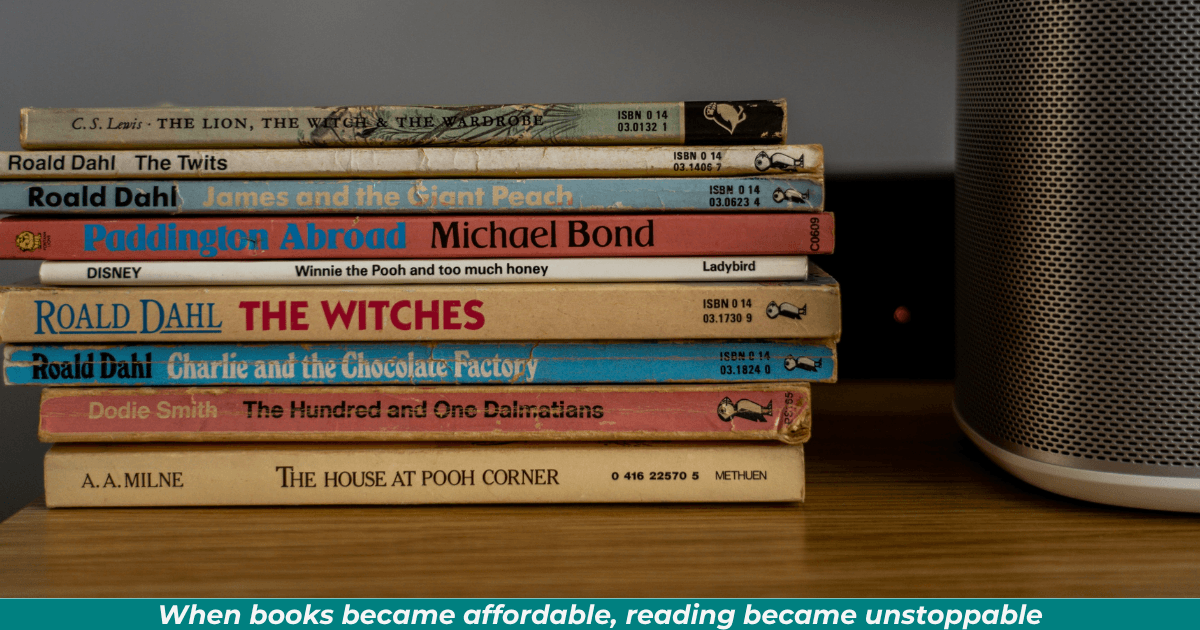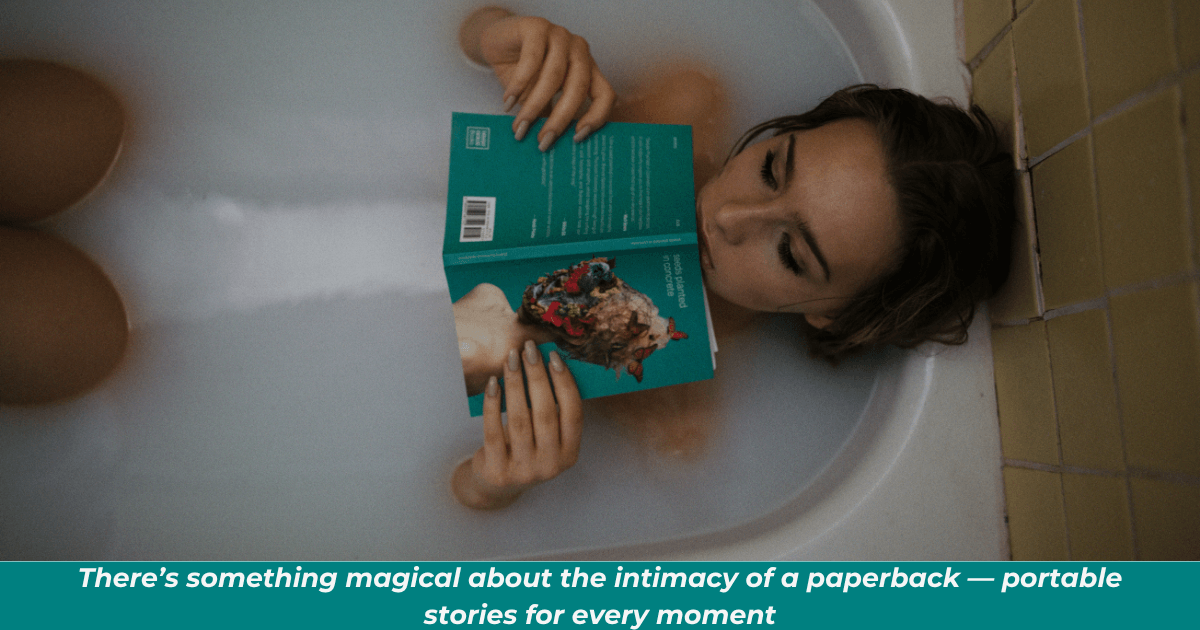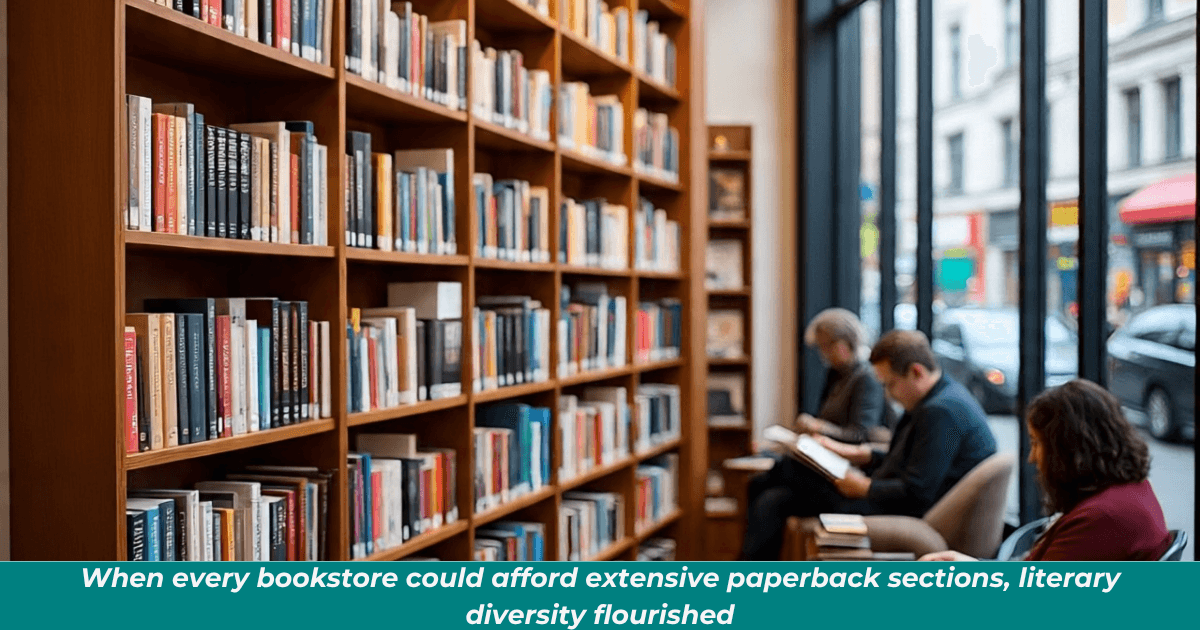
The Little Books That Changed Everything
Celebrating Paperback Book Day and the Revolution in Reading
July 30, 2025 | 9-minute read
July 30th is Paperback Book Day, and it’s time to celebrate one of publishing’s greatest democratizing forces.
These humble, affordable little books didn’t just change how we read — they changed who could read, what we could read, and where reading could happen.
Before paperbacks became widespread, books were expensive luxuries that many people simply couldn’t afford. Literature was largely the privilege of the wealthy, libraries were limited, and carrying a book meant lugging around a heavy hardcover tome.
Then came the paperback revolution, and suddenly everyone could have a personal library.
The Revolution That Fit in Your Pocket

The modern paperback as we know it really took off in the 1930s and 1940s, though the concept existed earlier.
Publishers realized they could reprint popular books in cheaper formats, making literature accessible to working-class readers who couldn’t afford hardcover editions.
Suddenly, you could buy a classic novel for the price of a magazine. You could slip a book into your purse or back pocket. You could read on the subway, at the beach, or during your lunch break without looking like you were carrying around a family heirloom.
Changing the Reading Landscape
Paperbacks didn’t just make books cheaper — they made reading more casual and approachable.
The informal format invited browsing, impulse purchases, and experimental reading. People felt comfortable buying books they might not finish, trying new authors, or picking up genres they’d never explored.
This accessibility led to an explosion in reading culture.
Book clubs became more popular because members could afford to buy the monthly selections. Genre fiction flourished because publishers could take risks on niche markets. Reading became a mainstream hobby rather than an elite pastime.
The Personal Connection

There’s something uniquely intimate about paperback books. Unlike their stately hardcover cousins, paperbacks invite handling. They’re meant to be loved, not preserved. You can fold back the covers, crack the spine, dog-ear the pages, and make them truly yours.
When I was a kid, I devoured books — and they were all paperbacks because that’s what kids read. My mom read hardcovers, but those always seemed like grown-up books to me. (Now, of course, I read both!)
But what I loved most about paperbacks then and now is that you can take them anywhere.
I’m not into eBooks, and even before their rise, I would stuff a paperback into my backpack or purse and whip it out when waiting for class to start, standing in line, or sitting in the doctor’s office. It’s simple and easy to haul a paperback around.
Yes, I know the tech elite would say it’s simpler to “haul” an eBook around, but what can I say? I’m old-school like that! Nothing beats an actual book — the feel, the smell, the sound of pages turning.
I love how paperbacks age with their readers.
A well-loved paperback tells the story of its journey — the slight yellowing of pages, the gentle wear along the edges, the way the spine softens after multiple readings.
These aren’t flaws; they’re evidence of a book that’s been truly lived with.
The Portability Factor
One of the greatest gifts paperbacks gave us was the ability to read anywhere.
Before lightweight paperbacks, taking a book on vacation meant making serious packing decisions. Now, you can travel with an entire mini-library without exceeding luggage weight limits.
I remember being in 5th grade when my teacher took three of us out for ice cream because our trio had won some class contest. We piled into her pickup truck, and I whipped out my paperback while she was driving.
I was in the passenger seat, and my teacher glanced my way and said, “You can read in a car?”
I looked up, confused, and answered, “Yeah.”
She shook her head, smiling. “I wish I could do that. But reading while in motion would make me carsick.”
I had no idea what she meant back then, so I just said I had to know what happened next in the story.
That’s the beauty of paperbacks — they made reading so natural and portable that it never occurred to me there were places you couldn’t read!
The Art of the Paperback Cover
Let’s take a moment to appreciate the often-overlooked art form of paperback cover design.
Without the premium materials and elaborate designs of hardcovers, paperback covers had to work harder to grab attention from crowded bookstore racks.
This led to some of the most iconic and memorable book cover art in publishing history. Bold colors, striking graphics, and clever typography became essential tools for making books stand out in the mass market.
Genre and Visual Identity
Paperback covers also helped establish visual languages for different genres.
Romance novels developed their distinctive cover styles, mystery books had their noir-influenced designs, and science fiction created its own futuristic aesthetic.
Readers could spot their preferred genres from across a bookstore.
These cover conventions weren’t just marketing tools — they were promises to readers about what kind of experience awaited inside.
The art became part of the reading culture, with certain cover artists developing devoted followings.
Democratizing Literature

Perhaps the most important legacy of paperbacks is how they democratized access to literature.
Suddenly, classic works that had been confined to libraries and expensive collections were available to anyone with pocket change.
This accessibility had profound cultural implications. More people could participate in literary conversations.
Students could own their textbooks instead of just borrowing them. Families could build home libraries without significant financial investment.
Expanding Literary Horizons
Affordable paperbacks also allowed publishers to take chances on diverse voices and experimental works.
When the financial risk was lower, they could publish books that might not have warranted expensive hardcover editions but could find their audiences in paperback format.
This led to greater diversity in published works and helped launch the careers of many authors who might not have found traditional publishing opportunities otherwise.
The Tactile Joy of Physical Books
In our increasingly digital world, paperbacks remind us of the sensory pleasures of physical books.
There’s the satisfying crack of a new spine, the distinctive smell of paper and ink, the tactile experience of turning pages.
Paperbacks offer these pleasures in their most accessible form.
They’re not precious objects that demand careful handling — they’re companions meant for real life, complete with coffee stains and beach sand between the pages.
The Romance of the Secondhand
Paperbacks also created thriving secondhand book markets.
Because they were affordable to begin with, people felt comfortable passing them along, trading them, or donating them.
This created a beautiful cycle where books could find multiple readers and live multiple lives.
Used bookstores became treasure troves of literary discovery, where you could find out-of-print editions, discover forgotten authors, or stumble across books you’d been meaning to read for years.
Paperbacks in the Digital Age
Despite the rise of eBooks and audiobooks, paperbacks continue to thrive.
In fact, print books have seen a resurgence in recent years, with many readers discovering that they prefer the physical experience of reading.
Paperbacks offer something that digital formats can’t: the ability to truly disconnect from screens and devices while still engaging with stories and ideas.
The Best of Both Worlds
Many modern readers enjoy a mixed approach — using eBooks for convenience and travel, audiobooks for commuting and exercise, but returning to paperbacks for deep reading and books they want to keep permanently.
This isn’t about one format being superior to others; it’s about having options that serve different reading needs and preferences.
Supporting Authors and Bookstores
Paperbacks continue to play a crucial role in supporting both authors and independent bookstores.
The lower price point makes them accessible to more readers, potentially expanding an author’s audience.
For bookstores, paperbacks offer better profit margins and faster inventory turnover than hardcovers.
They also remain popular gifts, book club selections, and impulse purchases — all of which help sustain the broader literary ecosystem.
Building Reading Communities
Paperbacks are still the format of choice for many book clubs, reading groups, and classroom discussions.
Their affordability makes it feasible for groups to read together, and their informal nature encourages the kind of active engagement that builds reading communities.
A Format Worth Celebrating
So this Paperback Book Day, let’s celebrate these humble literary revolutionaries.
They may not have the prestige of hardcovers or the convenience of eBooks, but they’ve done something perhaps more important: they’ve made reading accessible to everyone.
Whether you’re discovering a new author, revisiting an old favorite, or building your personal library one affordable book at a time, paperbacks continue to prove that great literature doesn’t need expensive packaging — it just needs passionate readers.
Here’s to the little books that changed everything, and to all the readers who’ve filled their lives with the portable magic of paperback literature.
What’s your relationship with paperback books? Do you have fond memories of particular paperback discoveries or a collection that holds special meaning?
Share your paperback stories in the comments — I love hearing about the books that have traveled through readers’ lives!
Related Topics: paperback books, reading accessibility, book history, affordable literature, book collecting, reading culture, physical books, bookstore culture, literary democracy, book appreciation
Images courtesy of Unsplash artists: John Salvino (featured image), Nik (SEO image), Nick Fewings (stack of classic paperbacks), and Thought Catalog (woman reading in tub). Image courtesy of Meta’s AI (bookstore with wall of paperbacks).

Alicia Strickland
Hi! I write across multiple genres under various pen names. But for nonfiction, I write as myself. As a designer with a love of Old Hollywood and all things creative, I bring diverse perspectives to my storytelling... and to my blog. In the unlikely event that I’m not writing, I enjoy crafting, gardening, or spending time with my flame-point Siamese, Hunter.
Want to stay updated? Sign up for my newsletter(below 👇) to receive exclusive content and be the first to hear about new releases!
YOU MIGHT LIKE

Jan 08, 2025
Jan 08, 2025
POPULAR POSTS
By Alicia Strickland on February 14, 2025
By Alicia Strickland
Jan. 05, 2025
REVIEWS

Jan 15, 2025
Dec 29, 2024
Jan 20, 2025
Feb 14, 2025

Crafting passionate tales for adult hearts and creating magical worlds for young minds!
Stay in touch!
Click “subscribe” to get weekly newsletter updates on all BBA news and books.
©️ 2025 booksbyalicia.com
